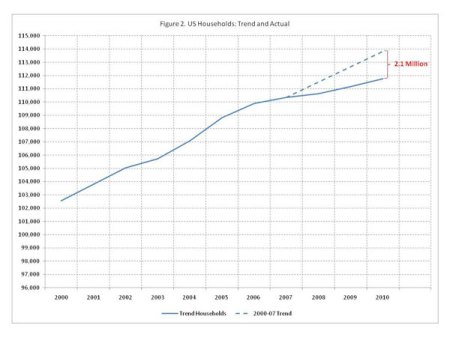Normal household growth since 1965 is 1.5% of households each year. But, between 2000and 2007, the household growth rate averaged 1%. Looking at total households, that means that 2.1 million of them did not happen during those seven years, that if economic times weren't so rough, may have formed. A new NAHB study by Dave Crowe, Robert Denk and Robert Dietz quantifies this level of pent-up demand. In it, they may have coined a new term in housing, "missing but expected." Inversely, the assumption is that many a potentially empty nest is full of adults in exceedingly close quarters.
There have been numerous estimates circulated of excess for-rent and for-sale housing supply, including one estimate of 3 million units by New York Federal Reserve President William Dudley.
This inventory of mostly existing homes (inventories of new construction are at historical lows – the Census Bureau estimates 190,000 units as of December 2010, down from 572,000 units in June 2006) are often cited as hurdles to new housing construction from growing from current depressed levels.
However, this excess supply is only half of the equation. There is also considerable pent-up housing demand or delayed household formations that have not yet been formed due to current economic conditions.
A new NAHB study by David Crowe, Robert Denk and Robert Dietz quantifies this level of pent-up demand.Since 1965 the number of households in the U.S. has been growing at about 1.5% per year. Between 2000 and 2007, the household growth rate was approximately 1.0%.
Applying the 1.0% rate against the 2007 Census measure of total households and comparing this trend level to the Census household counts for recent years yields an estimate of 2.1 million missing but expected households that have been delayed due to the Great Recession. Conceptually, these are younger workers who are still living at home with their parents and individuals who have doubled up with roommates due to an uncertain economy.
As the labor market improves, these potential households will be unlocked, helping to reduce the excess supply of housing – perhaps faster than many analysts expect.URL to original article: http://www.builderonline.com/builder-pulse/what-pent-up-demand-for-looks-like-statistically.aspx?cid=NWBD110210002



No comments:
Post a Comment